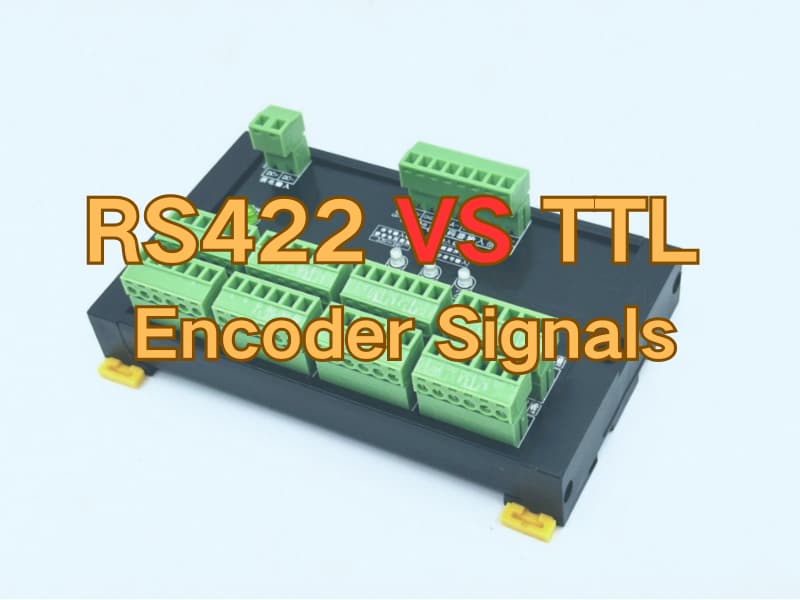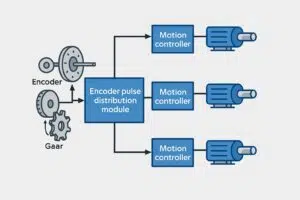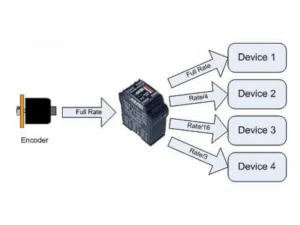Selecting the right encoder output standard is crucial to reliable automation control. The two most common choices—TTL (Transistor-Transistor Logic) and RS422 differential—offer distinct advantages in signal integrity, noise immunity, and wiring flexibility.
This article explains the engineering fundamentals, presents a comparison table, and offers guidance for selecting the best match for your PLC systems.
Understanding TTL and RS422 Basics
TTL Signals
TTL signals are single-ended, typically operating at 0V (low) and +5V (high). TTL outputs are easy to interface for short cable runs and offer fast transitions, but the single-ended structure leaves them open to voltage drops, electromagnetic interference (EMI), and noise, especially in industrial settings.
When the signal is “high,” the voltage is around +5 V; when “low,” it’s close to 0 V.
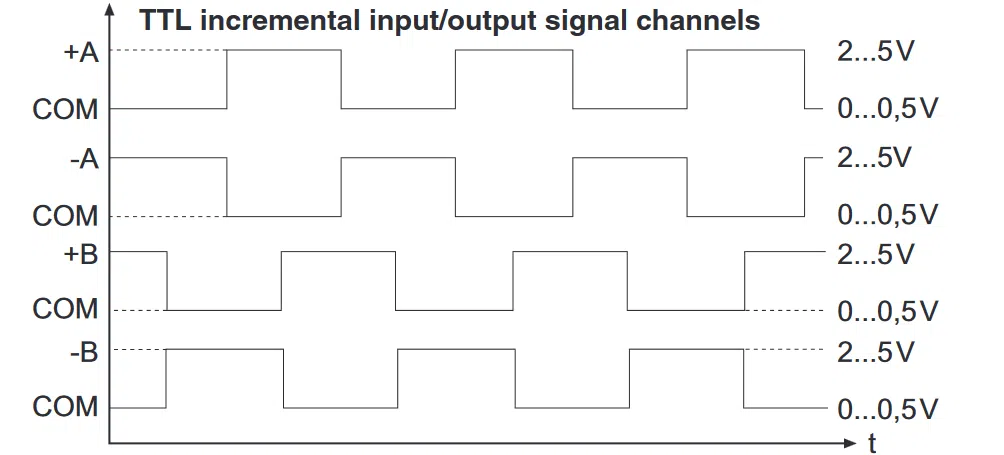
TTL wiring is simple — usually one wire per signal (A, B, Z) plus a ground. However, it uses single-ended transmission, meaning the signal’s return path is shared with other channels and the ground line. This makes TTL highly sensitive to electrical noise, voltage drop, and ground potential differences.
TTL is suitable for short cables (under 2 meters) and low-speed systems where electrical noise is minimal — for example, small laboratory equipment, desktop robots, or low-power test benches.
RS422 Signals
RS422, on the other hand, uses differential signal transmission. Each logical channel (A, B, Z) is transmitted as a pair of complementary signals: A +/A –, B +/B –, Z +/Z –.
The receiver measures the voltage difference between the positive and negative lines, not their absolute voltage to ground.

This design gives RS422 exceptional noise immunity. Any external interference typically affects both lines equally, and the differential receiver cancels the noise automatically.
Typical RS422 voltage levels are ±2 V to ±6 V differential, allowing signal transmission up to 100 meters or more without distortion when using twisted-pair shielded cables.
Key Points:
- TTL: Simple, cost-effective for close distances
- RS422: Industrial-grade, robust for long runs and high noise
Comparison Table – TTL vs RS422 Parameters
| Parameter | TTL Encoder Output | RS422 Encoder Output |
| Signal Type | Single-ended (A, B, Z + GND) | Differential (A +/A –, B +/B –, Z +/Z –) |
| Typical Voltage | 0 V – 5 V | ±2 V – ±6 V differential |
| Max Cable Length | ≤ 2 m (noise-free lab) | Up to 100 m (with twisted-pair cable) |
| Noise Immunity | Low – sensitive to EMI | High – differential cancellation |
| Signal Integrity | Degrades with distance | Maintained across long runs |
| Recommended Environment | Clean, short, low-speed systems | Industrial automation, noisy sites |
| Common Use | Small robots, test benches | Servo drives, PLC feedback systems |
When wiring long-distance encoder signals, see our detailed guide:
“Extending Encoder Signal Distance Without Loss” — it explains shielding, cable selection, and impedance matching techniques.
Why RS422 Is Standard in Industrial Systems
Industrial environments require robust, repeatable, and interference-resistant communication. RS422’s differential transmission meets all three requirements.
- Differential Transmission
Each signal is transmitted as a pair of opposite-polarity voltages. The receiver reads only their difference, so any common noise appearing on both lines is ignored. This provides up to 40 dB more noise rejection than TTL. - Shielded Twisted Pairs
RS422 cables typically use twisted-pair conductors with shielding. Twisting ensures that external magnetic fields induce equal voltages in both wires, which cancel out. The overall shield further protects against radio-frequency interference. - Electrical Isolation and Reliability
Many RS422 encoder modules include optoelectronic isolation between input and output. This isolation protects the PLC or motion controller from ground loops, surges, or mis-wiring — critical in 24-hour industrial operation. - Compatibility with Differential Drivers
Most modern PLCs and servo amplifiers include differential inputs designed for RS422 encoders. These inputs automatically reject noise and maintain accurate counting even in high-speed rotation.
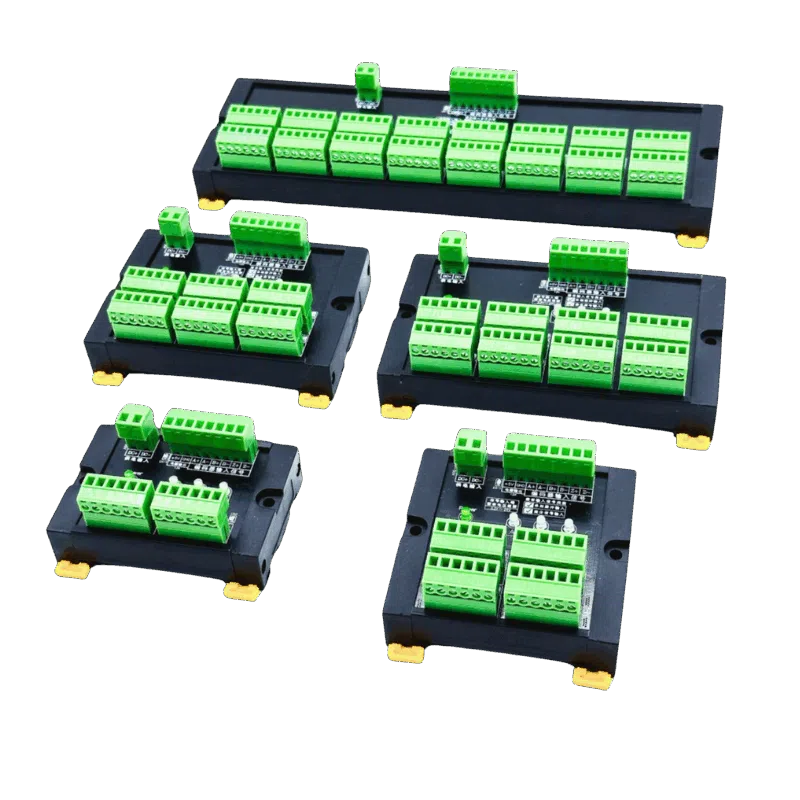
AOSI ABZ RS422 Distribution Module
- 8-channel isolated RS422 differential outputs – perfect for multi-controller encoder feedback. Each channel is buffered, isolated, and synchronized for long-distance, high-frequency operation.
This module allows engineers to split and distribute one encoder’s ABZ signals safely to multiple PLCs, servo drives, or monitoring units without voltage loss or timing errors. It’s designed specifically for industrial environments that demand stability and precision.
Choosing Between TTL and RS422 for PLCs
The right encoder output type depends on three main factors: distance, environment, and system compatibility.
- Cable Length
Under 2 m: TTL is acceptable when the encoder and controller are on the same board or panel.
2 m – 100 m: RS422 is the clear winner. Its line drivers maintain waveform quality across long runs with no additional amplifiers. - Electrical Environment
Clean, low-noise environments: TTL can work reliably in laboratories or test stations.
Industrial or high-EMI environments: RS422’s differential structure resists interference from motors, drives, and welding machines. - Controller Input Type
If your PLC or servo supports differential inputs (A+, A–, B+, B–), always select RS422.
For legacy TTL-only inputs, keep the cable short and use proper shielding or signal converters. - Signal Frequency and Resolution
High-resolution encoders produce pulse frequencies exceeding 100 kHz. At such speeds, TTL signals lose shape quickly, while RS422 maintains square-wave fidelity even beyond 500 kHz.
If your system involves fast motion or precise positioning, RS422 ensures accurate edge detection.
Summary and Recommendation:
| Requirement | Best Choice | Reason |
| Short distance, clean lab | TTL | Simple wiring, low cost |
| Long distance (> 2 m) | RS422 | Strong differential drive |
| High noise or industrial site | RS422 | Excellent EMI resistance |
| Multi-controller distribution | RS422 | Supports buffered, isolated outputs |
よくある質問
A1: RS422 uses differential transmission with superior noise immunity for industrial environments, while TTL is single-ended, suitable for short distances and low-noise lab setups.
A2: RS422 is better for industrial systems due to higher noise resistance, longer cable capability, and stable differential transmission compared to TTL wiring.
A3: TTL wiring is typically limited to under 2 meters, while RS422 encoders can transmit clean signals over 100 meters using shielded twisted-pair cables.
A4: Inspect cable quality, ensure proper shielding, confirm supply voltage, and use differential outputs or isolation modules for best stability.
A5: Yes. You can use a TTL-to-RS422 signal converter or a pulse distribution module to upgrade existing encoders for differential signal transmission.
A6: Use TTL encoders only for short-distance, low-noise environments such as lab equipment or small robots where cost and simplicity outweigh noise immunity.
結論
RS422 encoders are the industry standard for a reason. They offer superior signal integrity, noise rejection, and transmission distance. TTL encoders still have their place in small, controlled setups, but for any serious automation or PLC system, RS422 is the better, safer choice.
If you’re designing or upgrading your control cabinet, choose encoders and distribution modules with RS422 differential outputs — such as the AOSI Encoder Pulse Distribution Modules — to ensure long-term reliability and precision.

